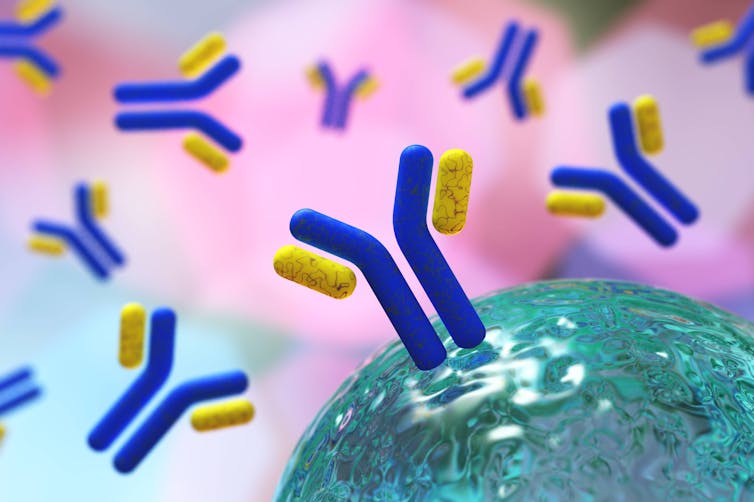We understand much of how the immune system works but, as recent efforts to combat COVID-19 have shown, its sheer complexity means many mysteries still remain. For example, how our immune system learns to remember past infections has proved very difficult to study in humans. But our new study has brought us one step closer to understanding how our body remembers past infections so we can fight them in the future. We uncovered the important role antibodies play in creating long-lived immunity – and that different types of immune cells, called B cells, can influence the type of immune memory generated.
Our research focused on so-called germinal centres which form during infections in our lymph nodes, spleen, and tonsils. These play an important role in our immune system, as they’re where immune cells assemble and interact during immune responses. They’re also where our “immune memory” is created, so the immune system can “remember” how to defend against certain pathogens in the future.
Germinal centres are made up of different immune cells, and one type, called B cells, are particularly important for generating immune memory. These B cells make antibodies (a protein) in response to infections or vaccinations, which bind to pathogens (like bacteria and viruses) and either destroy them or trigger other immune cells into action.
Early on in an infection, some of our body’s B cells respond by releasing a burst of antibodies that provide an early line of defence against the pathogen. But most of these B cells released in this initial first wave are short-lived and die once the infection is over, resulting in the loss of their antibodies. However, some B cells enter germinal centres where they can evolve stronger antibodies and become long-lived cells that protect us from future infection.
Germinal centres
Although the germinal centre is incredibly important to immune memory, its complexity has made it very difficult for scientists to completely understand how B cells behave while inside them. So we set out to create a “roadmap” of the germinal centre response using human tonsils to understand which types of B cells are present, and how their behaviour contributes to creating long-lived immunity. Knowing these factors could be important for developing effective vaccines.
We used a cutting-edge technology called single cell genomics, which measures the genes expressed by tens of thousands of individual cells and the genetic sequence that produces their antibody. The genes expressed by each individual B cell tells us about the cell’s behaviour and function, while the antibody gene sequence reveals how the antibodies change in the germinal centre. This approach allowed us to identify very rare types of B cells that would be missed with other technologies.
We then used this information to reconstruct the entire germinal centre response, which showed us exactly how different B cells evolve from the moment they detect a pathogen through to immune memory formation.
Antibody class
One of our key discoveries was that the type of antibody a B cell makes affects how it behaves and how likely it is to create long-lived immunity. B cells can express one of five antibody classes, and each class triggers different immune responses. For example, the antibody class IgG triggers strong antiviral immune responses, while the IgA class protects our gut and airway.

ustas7777777/ Shutterstock
All B cells start off making the antibody class IgM, which offers broad immune protection, but is less effective compared to other classes. But B cells can switch to another class when they are activated during an immune response. It was previously thought that this process of class switching occurs in the germinal centre. But recent studies in mice have found B cells switch their antibody class before the germinal centre response. We were able to confirm this happens in humans as well. We also identified which genes are expressed by B cells at this important stage.
We also found that B cells that had switched from making IgM to IgA or IgG antibodies express different levels of certain genes, including genes that control whether a B cell becomes long-lived. So, whether a B cell switches its antibody class before entering a germinal centre influences whether it develops long-lived immunity to that particular pathogen. However, we still don’t completely understand why a B cell switches or not.
Whether a B cell is part of the short-lived first wave or helps form the germinal centre also depends on many factors, including how quickly a pathogen is cleared, a person’s age, and the type of infection. Because B cells need germinal centres to develop immune memory, the more we can discover about these different factors, the better our understanding of our susceptibility to different diseases.
Understanding precisely how germinal centres work is key to designing effective vaccines that generate lifelong immunity. In the future, combining different technologies such as those we used in our study with other methods would allow us to directly compare immune responses to vaccines against many infectious agents, like the coronavirus SARS-CoV-2, and understand immune memory, more generally.
![]()
Dr Louisa James receives funding from the Wellcome Trust and Bart's Charity. She is affiliated with the British Society for Immunology.
Hamish King is a recipient of the Sir Henry Wellcome Post Doctoral Fellowship from the Wellcome Trust.











